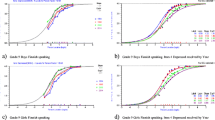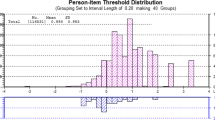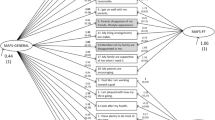Abstract
The PsychoSomatic Problems (PSP)-scale is built upon eight items intended to tap information about psychosomatic problems among schoolchildren and adolescents in general populations. The purpose of the study is to analyse the psychometric properties of the PSP-scale by means of the Rasch model, with a focus on the operating characteristics of the items. Cross-sectional adolescent data collected in Sweden at six points in time between 1988 and 2005 are used for the analysis. In all more than 15,000 students aged 15–16 are included in the analysis. Data were examined with respect to invariance across the latent trait, Differential Item Functioning (DIF), item categorisation and unidimensionality. The results show that the PSP-scale adequately meets measurement criteria of invariance and proper categorisation of the items. Also the targeting is good and the reliability is high. Since the scale works invariantly across years of investigation it is appropriate for re-current monitoring of psychosomatic health complaints in general populations of adolescents. Taking DIF into account through principles of equating provides a scale that shows no statistically significant signs of gender-DIF enabling invariant comparisons also between boys and girls.





Similar content being viewed by others
References
Achenbach, T. M. (1991a). Manual for the youth self report and 1991 profile. Burlington, VT: University of Vermont Department of Psychiatry.
Achenbach, T. M. (1991b). Manual for the child behavior checklist/4–18 and 1991 profile. Burlington, VT: University of Vermont Department of Psychiatry.
Andrich, D. (1978). A rating formulation for ordered response categories. Psychometrika, 43, 561–573.
Andrich, D. (1988). Rasch models for measurement. Newbury Park: Sage Publications.
Andrich, D. (2005). Rasch models for ordered response categories. In B. S. Everitt & D. C. Howell (Eds.), Encyclopedia of statistics in behavioral science. Chichester: John Wiley & Sons.
Andrich, D., Sheridan, B., & Luo, G. (2004). RUMM2020: A windows interactive program for analysing data with Rasch unidimensional models for measurement. Perth, Western Australia: RUMM Laboratory.
Attanasio, V., Andrasik, F., Blanchard, E. B., & Arena, J. G. (1984). Psychometric properties of the SUNYA revision of the psychosomatic symptom checklist. Journal of Behavioral Medicine, 7, 247–258.
Bland, J. M., & Altman, D. G. (1995). Multiple significance tests: the Bonferroni method. British Medical Journal, 310, 170.
Glass, G. V., & Hopkins, K. D. (1996). Statistical methods in education and psychology. Boston: Allyn and Bacon.
Goodman, R. (2001). Psychometric properties of the strengths and difficulties questionnaire. Journal of the American Academy of Child and Adolescent Psychiatry, 40, 1337–1345.
Hagquist, C. (2001). Evaluating composite health measures using Rasch-modelling: an illustrative example. Social and Preveventive Medicine, 46, 369–378.
Hagquist, C. (2007). The psychometric properties of the self-reported SDQ—an analysis of Swedish data based on the Rasch model. Personality and Individual Differences, 43, 1289–1301.
Hagquist, C., & Andrich, D. (2004a). Measuring subjective health among adolescents in Sweden: A Rasch-analysis of the HBSC-Instrument. Social Indicators Research, 68, 201–220.
Hagquist, C., & Andrich, D. (2004b). Is the sense of coherence-instrument applicable on adolescents? A latent trait analysis using Rasch-modelling. Personality and Individual Differences, 36, 955–968.
Hattie, J. (1985). Methodology review: Assessing unidimensionality of tests and items. Applied Psychological Measurement, 9, 139–164.
Haugland, S., Wold, B., Stevenson, J., Aaroe, L. E., & Woynarowska, B. (2001) ‘Subjective health complaints in adolescence. A cross-national comparison of prevalence and dimensionality’. European Journal of Public Health, 11, 4–10.
Hopland, K., Aaroe, L. E., & Wold, B. (1993). Sosialt nettverk, einsemd og kvardagsplager. Ei epidemiologisk undersöking blant 9. klassingar. [Social network, loneliness and everyday complaints. An epidemiological survey among adolescents]. Tidsskrift for Norsk Psykologforening, 30, 1174–1181.
Hurrelmann, K., Engel, U., Holler, B., & Nordlohne, E. (1988). Failure in school, family conflicts, and psychosomatic disorders in adolescence. Journal of Adolescence, 11, 237–249.
Rasch, G. (1960/80). Probabilistic models for some intelligence and attainment tests. (Copenhagen, Danish Institute for Educational Research). Expanded edition (1980) with foreword and afterword by B. D. Wright, (1980). (Chicago: The University of Chicago Press).
Smith, R. M. (2000). Fit analysis in latent trait measurement models. Journal of Applied Measurement, 1(2), 199–218.
Wisniewski, J. J., Naglieri, J. A., & Mulick, J. A. (1988). ‘Psychometric properties of a children’s psychosomatic symptom checklist’. Journal of Behavioral Medicine 11, 497–507.
Acknowledgment
A previous version of this paper was presented at The ACSPRI Social Science Methodology Conference 2006 at The University of Sydney, Sydney, Australia, 10–13 December 2006. My thanks to Professors David Andrich and Magnus Stenbeck for valuable comments on an earlier draft of this paper. The questionnaire that was used by the author to develop the PSP-scale was constructed by Curt Hagquist in collaboration with Bengt Starrin. My thanks to professor Starrin for his contribution.
Author information
Authors and Affiliations
Corresponding author
Rights and permissions
About this article
Cite this article
Hagquist, C. Psychometric Properties of the PsychoSomatic Problems Scale: A Rasch Analysis on Adolescent Data. Soc Indic Res 86, 511–523 (2008). https://doi.org/10.1007/s11205-007-9186-3
Received:
Accepted:
Published:
Issue Date:
DOI: https://doi.org/10.1007/s11205-007-9186-3




